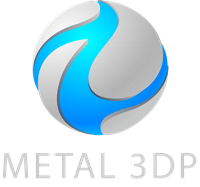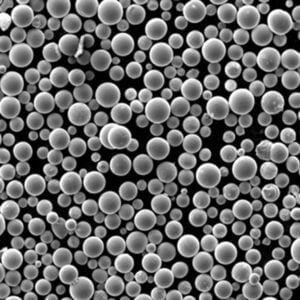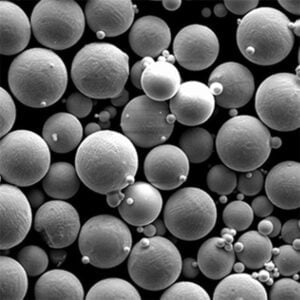Pulver aus rostfreiem Stahl ermöglichen den Druck komplexer Geometrien mit additiven Verfahren, die in der konventionellen Metallherstellung nicht möglich sind. Dieser Leitfaden enthält Legierungsvarianten, Partikelspezifikationen, Eigenschaftsdaten, Preisinformationen und Vergleiche für die Beschaffung von rostfreiem Pulver.
Einführung in Edelstahlpulver
Die wichtigsten Eigenschaften von Edelstahlpulvern:
- Herstellung komplexer, leichter Komponenten
- Erzielen Sie eine hervorragende Korrosionsbeständigkeit
- Ermöglicht schnelles Prototyping und Anpassungen
Zu den häufig verwendeten Legierungen gehören:
- 304L - Kostengünstig und mit ausgezeichneter Korrosionsbeständigkeit
- 316L - Hervorragende Korrosionsbeständigkeit mit Molybdänzusatz
- 17-4PH - Hochfestes, härtestes rostfreies Pulver
Dieser Leitfaden enthält Überlegungen zur Auswahl von rostfreien Pulvern:
- Legierungszusammensetzungen und Herstellungsverfahren
- Mechanische Eigenschaften Testdaten
- Empfehlungen für die Partikelgrößenverteilung
- Morphologie, Durchflussrate und scheinbare Dichte
- Lieferantenpreisspannen auf der Grundlage von Volumina
- Vergleiche der Korrosionsbeständigkeit
- Vor- und Nachteile im Vergleich zu massivem Stangenmaterial
- FAQs zur Optimierung von Druckparametern
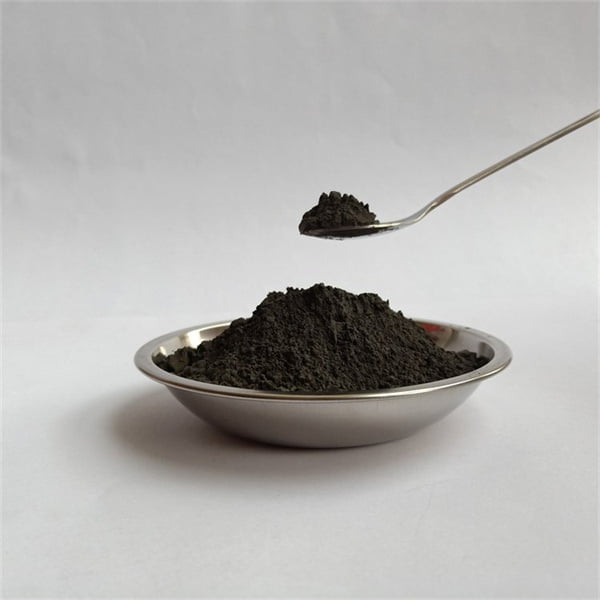
Edelstahl-Pulver-Zusammensetzungen
Tabelle 1 zeigt die Zusammensetzung von Edelstahlpulverlegierungen nach primären Elementzugaben, wobei es zwischen den Pulverherstellern gewisse Unterschiede gibt:
| Legierung | Wichtige Legierungselemente |
|---|---|
| 304L | Cr, Ni |
| 316L | Cr, Ni, Mo |
| 17-4PH | Cr, Ni, Cu |
Bei 304L und 316L ist der Kohlenstoffgehalt begrenzt (≤0,03%), um Karbidausscheidungen zu verhindern und die Korrosionsbeständigkeit und Schweißbarkeit zu erhalten.
Höherer Kohlenstoff in 17-4PH erhöht die Festigkeit durch martensitische Härtungswärmebehandlungen.
Mechanische Eigenschaften und Prüfverfahren
| Eigentum | Beschreibung | Test Method (Standard) | Importance for Additive Manufacturing (AM) |
|---|---|---|---|
| Scheinbare Dichte | Mass of powder per unit volume in its loose, uncompacted state | ASTM B922 | Influences powder flowability and ease of handling in AM processes |
| Fließfähigkeit | Ease with which powder particles flow under gravity | ASTM B2132 | Affects packing density and powder layer uniformity in AM builds |
| Zapfstellendichte | Density of powder after a standardized tapping routine | ASTM B854 | Provides a basic assessment of powder packing efficiency |
| Green Density | Density of a compacted powder body before sintering | ASTM B970 | влияет (vliyaniyet) on final density and dimensional accuracy of AM parts (influyats na final’nuyu plotnost’ i razmernuyu tochnost’ detaley AM) |
| Gesintert Dichte | Density of a powder body after sintering | ASTM B962 | Critical for achieving desired mechanical properties and corrosion resistance in AM parts |
| Partikelgrößenverteilung | Range of sizes present in a powder population | ASTM B822 | Impacts powder flowability, packing behavior, and final microstructure of AM parts |
| Partikelform | Morphological characteristics of individual powder particles (spherical, angular, etc.) | Scanning Electron Microscopy (SEM) | влияет (vliyaniyet) on packing density, inter-particle bonding, and flowability (influyats na plotnost’ upakovki, mezhchastichnoe svyazyvanie i tekuchest’) |
| Oberflächenrauhigkeit | Microscopic variations on the surface of a powder particle | Atomic Force Microscopy (AFM) | Can influence inter-particle bonding and sintering behavior |
| Chemische Zusammensetzung | Elemental makeup of the powder material | X-Ray Fluorescence (XRF) | Determines final material properties, corrosion resistance, and suitability for specific applications |
| Zugfestigkeit | Maximum stress a powder metallurgy (PM) specimen can withstand before pulling apart | ASTM E8 | Crucial for applications requiring high load-bearing capacity |
| Streckgrenze | Stress level at which a PM specimen exhibits plastic deformation | ASTM E8 | Important for understanding material’s elastic limit and predicting permanent deformation |
| Dehnung | Percentage increase in length a PM specimen experiences before fracture in a tensile test | ASTM E8 | Indicates material’s ductility and ability to deform without breaking |
| Druckfestigkeit | Maximum stress a PM specimen can withstand before crushing under compressive load | ASTM E9 | Essential for applications experiencing compressive forces |
| Härte | Resistance of a material to indentation by a harder object | ASTM E384 | Relates to wear resistance and surface properties |
| Ermüdungsfestigkeit | Maximum stress a PM specimen can endure under repeated loading and unloading cycles without failure | ASTM E466 | Critical for components subjected to cyclic stresses |
| Bruchzähigkeit | Material’s ability to resist crack propagation | ASTM E399 | Important for safety-critical applications where sudden failure cannot be tolerated |
Empfehlungen für die Partikelgröße von Edelstahlpulver
| Anmeldung | Median Particle Size (D₅₀) | Partikelgrößenverteilung (PSD) | Form | Wichtige Überlegungen |
|---|---|---|---|---|
| Metal Additive Manufacturing (Laser Melting, Electron Beam Melting) | 15-45 Mikrometer | Narrow (Tight distribution around D₅₀) | Sphärisch | – Fließfähigkeit: Spherical particles flow more easily, enabling consistent layer formation. – Packungsdichte: Smaller particles can pack more tightly, reducing porosity in the final product. – Oberfläche: Extremely fine particles (<10 microns) can cause surface roughness. – Laser Absorption: Particle size can influence laser absorption efficiency, impacting melting behavior. |
| Metall-Spritzgießen (MIM) | 10-100 Mikrometer | Broad (Wider distribution for packing and sintering) | Unregelmäßig | – Pulverfluss: Irregular shapes can interlock, improving powder flow during injection molding. – Packungsdichte: A broader size distribution allows for better packing, reducing shrinkage during sintering. – Sintering Efficiency: Larger particles can hinder complete sintering, affecting mechanical properties. – Entbinden: Large particles and broad distributions can trap debinding agents, leading to residual porosity. |
| Plasma Spraying | 45-150 Mikrometer | Broad (Similar to MIM) | Unregelmäßig | – Impact Resistance: Larger particles improve impact resistance in the final coating. – Deposition Efficiency: Irregular shapes can enhance mechanical interlocking, improving coating adhesion. – Splat Morphology: Particle size influences splat formation during spraying, impacting coating microstructure. – Recoatability: Broader distributions may improve the ability to create smooth, layered coatings. |
| Thermal Spraying (High Velocity Oxygen Fuel, Detonation Gun) | 45-250 microns | Broad (Similar to MIM) | Unregelmäßig | – Deposition Rate: Larger particles allow for faster deposition rates. – Particle Velocity: High-velocity processes require robust particles to minimize in-flight fracturing. – Coating Density: Broader distributions can promote denser coatings, but particle size can also affect packing efficiency. – Oxidationsbeständigkeit: Larger particle sizes can reduce surface area, potentially improving oxidation resistance. |
| Additive Manufacturing (Binder Jetting) | 10-50 Mikrometer | Narrow (Similar to Laser Melting) | Sphärisch | – Auflösung: Smaller particles enable finer feature details in the printed part. – Green Strength: Particle size and distribution can influence the strength of the unfired part. – Binder Compatibility: Particle surface area can affect binder adhesion and printability. – Moisture Sensitivity: Extremely fine powders may be more susceptible to moisture absorption, impacting handling. |
Pulvermorphologie, Fließgeschwindigkeit und Dichte
| Eigentum | Beschreibung | Importance in Powder Processing |
|---|---|---|
| Morphologie des Pulvers | The size, shape, and surface characteristics of individual powder particles. | Morphology significantly impacts packing density, flowability, and laser absorptivity in Additive Manufacturing (AM). Ideally, spherical particles with smooth surfaces offer the best packing density and flow characteristics. However, atomization processes can introduce variations. Gas-atomized powders tend to be more spherical, while water-atomized powders exhibit a more irregular, splattered morphology. Additionally, surface features like satellites (small particles attached to larger ones) and satellites can hinder flow and affect laser melting behavior in AM. |
| Partikelgrößenverteilung (PSD) | A statistical representation of the variation in particle sizes within a powder batch. It is typically expressed as a cumulative distribution curve or by reporting specific percentiles (e.g., d10 – 10% of particles are smaller than this size, d50 – median particle size). | PSD plays a crucial role in powder bed packing and influences the final density and mechanical properties of AM parts. A narrow PSD with a well-defined median size (d50) is preferred for consistent packing and laser melting depth. Conversely, a broad distribution can lead to segregation (larger particles separating from finer ones) during handling and uneven melting in the AM process. |
| Scheinbare Dichte & Klopfdichte | * Apparent density: The mass of powder per unit volume when poured freely into a container. * Tap density: The density achieved after a standardized tapping or vibration protocol. | These properties reflect the packing behavior of the powder and are crucial for efficient powder handling and storage. Apparent density represents the loose packing state, while tap density indicates a denser packing achieved through mechanical agitation. The difference between these values, known as the Carr angle, is an indirect measure of flowability. Powders with a lower Carr angle (higher tap density closer to apparent density) exhibit better flow characteristics. |
| Durchflussmenge | The rate at which powder flows under gravity through an orifice or hopper. | Flow rate is critical for consistent material feed in various powder processing techniques like AM and metal injection molding (MIM). Good flowability ensures smooth powder layer formation and avoids disruptions during the build process. Irregular particle shapes, presence of satellites, and moisture content can hinder flow rate. Manufacturers often employ flowability additives like lubricants to improve powder flow. |
| Dichte des Pulvers | The mass of powder per unit volume of the solid particles themselves, excluding voids between particles. | Powder density is a material property inherent to the specific stainless steel composition. It influences the final density achievable in the finished product after sintering or melting. Higher powder density typically translates to higher final product density and improved mechanical properties. |
Preise für Edelstahl-Pulver
| Faktor | Beschreibung | Auswirkungen auf den Preis |
|---|---|---|
| Klasse | The specific type of stainless steel, designated by a three-digit number (e.g., 304, 316L, 17-4PH). Different grades offer varying degrees of corrosion resistance, strength, and formability. | Higher-grade stainless steel powders, like 316L with molybdenum for enhanced corrosion resistance, typically command a premium price compared to basic grades like 304. |
| Partikelgröße und -verteilung | The size and uniformity of the powder particles. Measured in microns (μm) or mesh size (number of openings per linear inch in a sieve), particle size significantly influences the final product’s properties and manufacturing process. | Finer powders (smaller microns/higher mesh size) generally cost more due to the additional processing required to achieve a narrower particle size distribution. However, finer powders can enable intricate details and smoother surface finishes in 3D printed parts. |
| Fläche | Closely linked to particle size, the total surface area of the powder particles per unit weight. Powders with higher surface areas tend to be more reactive and require stricter handling protocols. | Powders with high surface areas may incur additional costs due to specialized handling and storage requirements to prevent contamination or moisture absorption. |
| Herstellungsprozess | The method used to produce the stainless steel powder. Common techniques include atomization (gas or water) and chemical vapor deposition (CVD). | Atomization processes are generally more established and cost-effective, while CVD yields finer and purer powders but at a higher price point. |
| Reinheit | The chemical composition of the powder, with minimal presence of unwanted elements. | Higher purity powders, with lower levels of oxygen, nitrogen, and other impurities, often come at a higher cost due to stricter manufacturing controls. |
| Spherical Morphology | The shape of the powder particles. Spherical particles offer superior flow characteristics and packing density, leading to improved printability and material utilization. | Spherical stainless steel powders are generally more expensive compared to irregular-shaped particles due to the additional processing steps involved. |
| Menge | The amount of stainless steel powder purchased. | Bulk purchases typically benefit from significant price reductions due to economies of scale offered by suppliers. |
| Marktschwankungen | The global supply and demand dynamics for raw materials like chromium and nickel, which significantly impact the base price of stainless steel feedstock. | Periods of high demand or supply chain disruptions can cause price increases for stainless steel powders. |
| Anbieter | The reputation and expertise of the powder manufacturer. Established brands with rigorous quality control procedures may command a slightly higher price compared to lesser-known suppliers. | Reputable suppliers often provide additional services like technical support and material certifications, which can justify a slight price premium. |
Edelstahl-Pulver Korrosionsbeständigkeit
| Eigentum | Beschreibung | Impact on Corrosion Resistance |
|---|---|---|
| Chromgehalt | The key element in stainless steel’s corrosion resistance. It forms a thin, invisible layer of chromium oxide on the surface when exposed to oxygen, acting as a barrier against further oxidation (rust). | Higher chromium content (typically above 10.5%) translates to better corrosion resistance. Different grades of stainless steel powder have varying chromium levels, catering to specific environments. |
| Molybdän | Often added to improve resistance to pitting corrosion, a localized form of attack that creates deep holes in the metal. Molybdenum enhances the stability of the chromium oxide layer, particularly in environments containing chlorides (e.g., seawater). | Stainless steel powders with molybdenum are ideal for marine applications, chemical processing involving chlorides, and high-salinity environments. |
| Nickel | Contributes to overall corrosion resistance, particularly in high-temperature settings. Nickel helps maintain the stability of the passive oxide layer and improves resistance to reducing acids. | Nickel-containing stainless steel powders are well-suited for applications involving hot acidic environments or high-pressure steam. |
| Powder Manufacturing Method | The process used to create the powder can influence its microstructure and, consequently, corrosion resistance. Gas atomization, a common method, can trap oxygen within the particles, potentially leading to localized corrosion. | Choosing powders produced with methods minimizing internal oxidation, like water atomization, can enhance corrosion performance. |
| Porosität | Sintering, the process of bonding powder particles, can leave behind tiny pores within the final product. These pores can act as initiation sites for corrosion if they trap contaminants or moisture. | Selecting powders with optimized particle size distribution and proper sintering parameters minimizes porosity, leading to improved corrosion resistance. |
| Oberfläche | The surface topography of the finished component can influence how readily it interacts with the environment. Rougher surfaces offer more area for contaminants and moisture to adhere, increasing the risk of corrosion. | Smoother surface finishes, achievable through polishing or specific manufacturing techniques, enhance corrosion resistance by minimizing these potential sites. |
| Korngröße | The size of individual metal grains within the sintered component can affect corrosion behavior. Finer grain sizes generally offer better corrosion resistance as they present a less permeable barrier to corrosive agents. | Selecting powders optimized for achieving fine grain structures during sintering can enhance the component’s ability to resist corrosion. |
Vor- und Nachteile: Pulver- und Massivholzstangen
Tabelle 7
| Vorteile | Benachteiligungen | |
|---|---|---|
| Edelstahl-Pulver | Komplexe Formen | Höhere Kosten |
| Hohe Korrosionsbeständigkeit | Nachbearbeitung | |
| Gewichtsreduzierung | Optimierung der Druckparameter | |
| Edelstahl Vollstab | Kostengünstig | Grenzen der Form |
| Verfügbarkeit | Viel schwerer | |
| Bearbeitbarkeit | Materialverschwendung |
Im Allgemeinen rechtfertigt Edelstahlpulver höhere Preise für komplexe Bauteile in kleinen Stückzahlen, bei denen Korrosionsbeständigkeit und Gewichtsreduzierung entscheidend sind. Stangenformate sind erschwinglich für einfache Formen in der Großserienfertigung.
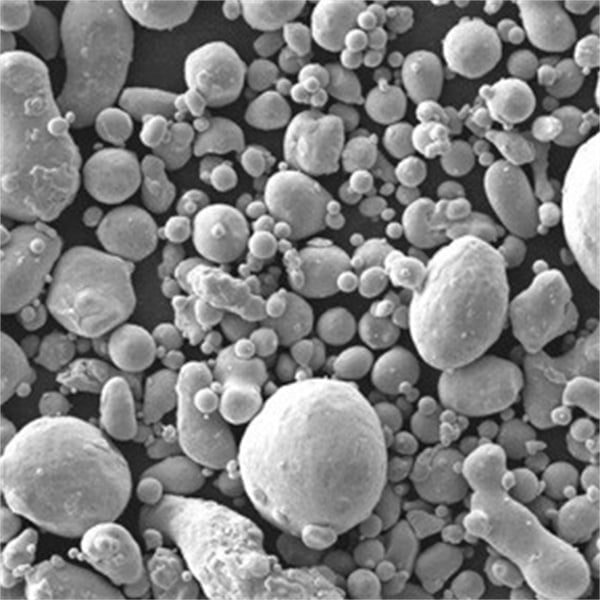
FAQs
Tabelle 8 - Allgemeine Fragen:
| FAQ | Antwort |
|---|---|
| Sollte ich Prüfberichte überprüfen? | Ja, prüfen Sie die Daten der Pulverbescheinigung gründlich |
| Mit welcher Größe von Pulverpartikeln sollte ich beginnen? | 25-45 Mikron für robusten Druck |
| Welche Faktoren beeinflussen die Konsistenz? | Die Technik der Rohpulverherstellung beeinflusst die Variabilität |
| Wie viel Pulver sollte ich anfangs kaufen? | Beginnen Sie in kleinem Maßstab, um den Druckprozess zu validieren |
Tabelle 9 - Anwendungsorientierte Beratung:
| FAQ | Antwort |
|---|---|
| Wie sollte ich die Parameter für das Bedrucken von lebensmittelechten Edelstahlgeräten einstellen? | Optimierung für geringe Oberflächenrauhigkeit und Beseitigung von Rissen |
| Durch welche Nachbearbeitung kann die Porosität von Schiffsteilen verringert werden? | Erwägen Sie das heißisostatische Pressen, um die Korrosionsbeständigkeit zu maximieren. |
| Welche Legierung maximiert die Streckgrenze für tragende Bauteile? | 17-4PH ausscheidungsgehärtetes Edelstahl |
| Welches Edelstahlpulver ist optimal für Hochtemperatur-Ofenteile? | 316L-Pulver bietet hervorragende Oxidationsbeständigkeit |
